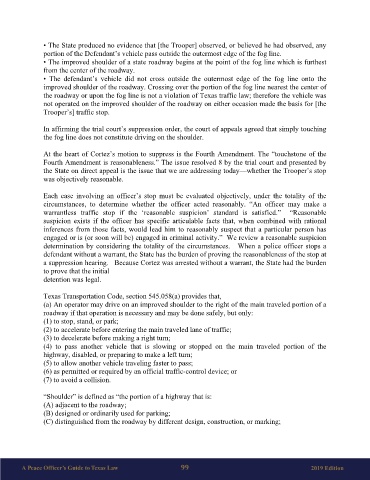Page 107 - 2019 A Police Officers Guide
P. 107
• The State produced no evidence that [the Trooper] observed, or believed he had observed, any
portion of the Defendant’s vehicle pass outside the outermost edge of the fog line.
• The improved shoulder of a state roadway begins at the point of the fog line which is furthest
from the center of the roadway.
• The defendant’s vehicle did not cross outside the outermost edge of the fog line onto the
improved shoulder of the roadway. Crossing over the portion of the fog line nearest the center of
the roadway or upon the fog line is not a violation of Texas traffic law; therefore the vehicle was
not operated on the improved shoulder of the roadway on either occasion made the basis for [the
Trooper’s] traffic stop.
In affirming the trial court’s suppression order, the court of appeals agreed that simply touching
the fog line does not constitute driving on the shoulder.
At the heart of Cortez’s motion to suppress is the Fourth Amendment. The “touchstone of the
Fourth Amendment is reasonableness.” The issue resolved 8 by the trial court and presented by
the State on direct appeal is the issue that we are addressing today—whether the Trooper’s stop
was objectively reasonable.
Each case involving an officer’s stop must be evaluated objectively, under the totality of the
circumstances, to determine whether the officer acted reasonably. “An officer may make a
warrantless traffic stop if the ‘reasonable suspicion’ standard is satisfied.” “Reasonable
suspicion exists if the officer has specific articulable facts that, when combined with rational
inferences from those facts, would lead him to reasonably suspect that a particular person has
engaged or is (or soon will be) engaged in criminal activity.” We review a reasonable suspicion
determination by considering the totality of the circumstances. When a police officer stops a
defendant without a warrant, the State has the burden of proving the reasonableness of the stop at
a suppression hearing. Because Cortez was arrested without a warrant, the State had the burden
to prove that the initial
detention was legal.
Texas Transportation Code, section 545.058(a) provides that,
(a) An operator may drive on an improved shoulder to the right of the main traveled portion of a
roadway if that operation is necessary and may be done safely, but only:
(1) to stop, stand, or park;
(2) to accelerate before entering the main traveled lane of traffic;
(3) to decelerate before making a right turn;
(4) to pass another vehicle that is slowing or stopped on the main traveled portion of the
highway, disabled, or preparing to make a left turn;
(5) to allow another vehicle traveling faster to pass;
(6) as permitted or required by an official traffic-control device; or
(7) to avoid a collision.
“Shoulder” is defined as “the portion of a highway that is:
(A) adjacent to the roadway;
(B) designed or ordinarily used for parking;
(C) distinguished from the roadway by different design, construction, or marking;
A Peace Officer’s Guide to Texas Law 99 2019 Edition

